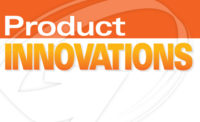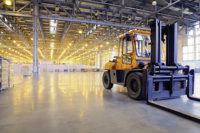Powered industrial trucks—forklifts—are commonplace in manufacturing and warehousing facilities. They are crucial to ensure the safe material transport of goods. They can also be deadly.
Reported statistics place the number of forklift-related accidents at close to 100,000 per year (100 fatal accidents, 34,900 serious injury accidents, and 61,800 non-serious accidents). More than 40 percent of fatalities are due to the forklift rolling or toppling on top of the operator or other worker.
Individuals who handle heavy material handling equipment such as forklifts need to take special precautions to ensure that the materials they transport are properly handled. The safest place for a driver to be is strapped into a seat with a seat belt.
Hazards associated with operation include mounting and dismounting (risk of head injury, slips, trips, and falls); starting and stopping; operating at speeds (risk of tip overs and collisions with pedestrians or objects); steering, turning, and changing direction (risk of tip overs and collisions with pedestrians or objects); reversing (risk of risk of tip overs and collisions with pedestrians or objects); travelling on inclines (risk of tip overs and falling loads); parking (risks of collisions or unintended movement).
Load handling presents an additional set of hazards to operators. Off-center loads, overloading, and damaged or loose loads can all cause tip over or falling loads and collisions if the driver’s view is impaired. Moving loads onto truck trailers or railroad cars can cause falling and tip over hazards, as well as potential hazards to other workers.
Forklifts can be especially dangerous for pedestrians. OSHA’s website contains several sections dedicated to the dangers associated with forklifts. If you work with or around powered industrial truck, make sure you’re informed and aware of the dangers.
Forklift collisions
OSHA estimates there are 1.5 million lift operators in the United States. That’s a lot of lifts, and a lot of people around lifts. Forklifts and workers must remain apart. There are differing perspectives on who should have right of way (who yields to whom).
Until recently, there wasn’t any language that clearly specified which party should have right-of-way. The 1969 forklift consensus standard that OSHA references just says to stay out of the way of ambulances, fire trucks, and other vehicles in emergency situations. The 2015 version of the ANSI standard, Section 5.3.2 provides the updated guidance to lift operators, “Yield the right of way to pedestrians and emergency vehicles such as ambulances and fire trucks.”
Forklifts are the second leading cause of machine-related death in the workplace. Struck-by and tip-over are the two leading causes of forklift-related fatalities. Each year in the United States, on average, 100 die, 95,000 are injured, and 20,000 are seriously injured. An average of 60 lost workdays is incurred per incident (9x the average for all other injuries). Bad things happen when people and lifts attempt to share the same place in time.
Currently more than half of all U.S. states are covered by OSHA Local Emphasis Programs that target industrial trucks and warehouse safety. Compliance officers will look more thoroughly at lift operations and may be more likely to visit industries known to operate lifts.
Losers in collisions; winners in court
Consensus standards, such as ANSI standards, are more than suggestions. Consensus standards define the generally agreed upon standard of care, which matters in a court of law. And they define hazards and precautions that should have been recognized, which matters when OSHA “General Duty” catch-all clause citations are issued.
The message is and always has been the same: separate forklifts and pedestrians. People are vulnerable relative to industrial vehicles and people generally have the right of way in plant settings (just as they would on public streets). Things usually play out this way in jury trials where negligence lands on forklift operators more times than not.
In August of 2015, $15.2 million in relief was awarded to a worker whose foot was seriously injured when he was struck and run over by a forklift at a trade show in Chicago. The forklift operator worked for the show’s organizer who was breaking down booths; the injured party was representing an exhibitor at the show. OSHA citations totaling $91,000 were issued for failing to ensure driver training, failing to ensure safe clearances for forklift operations, failing to train drivers on specific issues related to pedestrians present, and other related issues. The prosecution called attention to the weight of the lift (58,000 pounds) and entered testimony from witnesses alleging that the driver did not keep a clear view of his path and did not maintain a proper lookout or spotter.
In this case and others, most of the responsibility falls on lift operators. Cases like this imply pedestrians have right of way. Cases like this also show that being right doesn’t always equate to staying safe.
Preventing collisions
There has been a lot of regulatory focus on forklift operators, yet frequency and severity remain relatively high in comparison to other industry exposures. Perhaps regulators have focused on the wrong thing? Maybe forklift operators are not solely to blame when workers are struck by forklifts?
There is no standard that speaks to the responsibility of pedestrians. Leading companies preach mutual responsibility or “safety is everyone’s responsibility” and educate about the severity of forklift incidents, lift and operator limitations, and how to establish intentions through eye contact and hand signals.
Beyond education of lift operators and pedestrians, the workplace and lifting equipment must be maintained in good operating condition. This includes ensuring adequate lighting, good floor conditions and housekeeping, marking and protecting walk aisles, and allocating aisle widths conducive to lift operation. Last but not least, employer management systems must ensure proper diagnosis and closure of incidents and issues voiced.
When pedestrians and lifts collide, everybody loses. It’s important that everyone knows what their responsibility is.
OSHA statistics and forklift hazards written by UL EHS Sustainability Editorial Team and posted on www.ulehssustainability.com. Forklift collisions written by Jonathan Jacobi and posted on www.ulehssustainability.com . UL’s senior leaders and diverse team of safety, health, environmental and risk management subject matter experts regularly write insightful articles and white papers that help define and promote best practices and explore emerging trends in workplace health and safety. UL EHS Sustainability, 5000 Meridian Blvd., Suite 600, Franklin, TN 3706.



